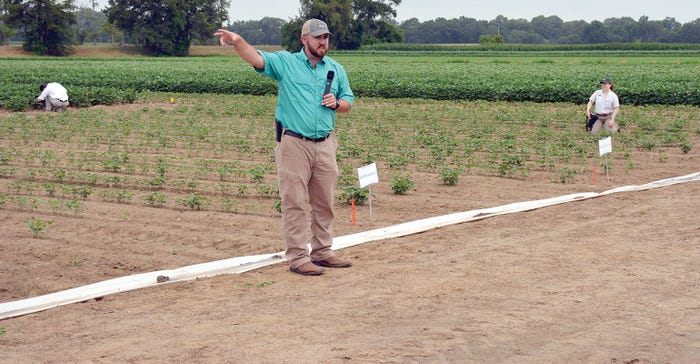
Editors' note: Sources at the LSU AgCenter in Winnsboro report a widespread rain, totaling about one-third inch, fell Tuesday evening, bringing much-needed relief to area farms. More will be needed to finish out the crops.
Crop specialists on hand for the LSU AgCenter Expo at the Scott Research, Extension and Education Center held Tuesday in Winnsboro, La., said weather has been a factor since corn planting time.
The season got off to a slow start in March with cold, wet conditions that delayed corn planting, then it turned hot and dry.
“We’re irrigating corn now,” said Dan Fromme, associate professor and Extension corn and cotton specialist from the AgCenter in Alexandria, La. He said planting time was wet and cold. “We didn’t get corn planted in a timely manner. Then April and May turned dry and June is following suit.”
He says 60 percent of the state’s corn acreage is irrigated. Still, yields likely will be off because of the dry weather. “Also, temperatures have been higher than usual. Those factors aren’t good for corn yields.”
Cotton started well
Cotton got off to a good start. “You couldn’t ask for better conditions,” Fromme says. “We had enough soil moisture to plant and temperatures were warm. About 80 percent of our acreage was planted from May 1 to May 15.
“Since then, we’ve gotten only sporadic rainfall, but cotton will hang on longer than corn or soybeans. But we’re near the end of June, the bloom period, so we are going to need rain very soon. Otherwise, we could be in a very serious situation.”
Fromme says about 50 percent of Louisiana’s cotton acreage is irrigated.
Soybeans
Louisiana’s soybean crop got a slow start, too, caught up some with warm April and May temperatures and by late June needed rain.
Louisiana Extension soybean specialist Todd Spivey, said March-planting was sluggish. “March was cold and wet, and a lot of beans that would have gone in in March were slow.”

Todd Spivey, LSU Extension soybean specialist, discusses soybean seeding rates at a tour stop on the Macon Ridge Research station in Winnsboro, La.
He said even into April, conditions remained wet and cold. “A lot of our beans weren’t planted until the first or second weeks of May. We’ve come a long way since then, but when the wet weather turned off, it turned really dry, really fast.
“Now, were beginning to catch a little rain and the beans are looking pretty good, considering. It’s one of those things, if we’re going to have a drought, we’d rather have it early in the year.”
He says pest pressure has also been slow to develop. “About 60 to 75 percent of our beans are beginning to bloom across the state, so we are getting into the meat of the season. The goal going forward is to keep the beans stress-free.”
That may be difficult unless the hot, dry weather that has persisted across the state for the last two months changes.
Spivey says only 15 percent to 20 percent of the state’s soybean acreage is irrigated. “So, we need the rain.”
Drought is creating complications for cotton insect pest control for Louisiana producers. But for corn and soybean insects, “it’s quiet.”
Cotton insect pests
Sebe Brown, LSU Extension entomologist, Alexandria, says some fields have cotton at the two true-leaf stage with some 11 or 12 true-leaf cotton that has squares, “actually squaring pretty good. So, we’re having a lot of challenges. Some producers are controlling thrips on one side and plant bugs on the other at the same time.”
That problem results from the crop running out of moisture or early season producers who just didn’t finish planting. He says in some cases one part of the field may have had moisture and the other did not, so germination was uneven across the field.
Brown says Bidrin may be the best option. It controls plant bugs and thrips. “We don’t have a lot of options. We can use acephate, but are concerned about spider mites because it’s so dry and so hot. Acephate also could flare aphids and other insects. Growers want to stay soft early in the season. That’s what we practice with IPM; try, as much as possible, not to flare any secondary pests.”
But, he says the unusual season, with uneven cotton, may require producers to break out some of the tools they typically use later, because that’s about all they have available to control “a myriad of pests on early-season and almost pre-flower cotton.”
Soybean pests
Brown says, “soybeans have been quiet, no pest problems. The red-banded stinkbug has not been an issue. I talked to a consultant last week who scouts south of I-10. He found his first red-banded stinkbug last week in R-5 beans.”
He says the scout caught only two in “about 100 sweeps. Typically, the guys in south Louisiana get infestations first, then they work their way north up to us. Outside of that one consultant, I have yet to hear of anyone identifying a red-banded stinkbug.”
He says bollworm pressure is also light. “We are not seeing the bollworm pressure that our counterparts to the east and north are seeing. It’s kinda rare that we see bollworms at all in Louisiana. We’re not seeing it in corn, either. I’m hearing a lot of producers say this is the lightest corn earworm year they have ever seen. Hopefully, we will have a light year for worms.”
About the Author(s)
You May Also Like






